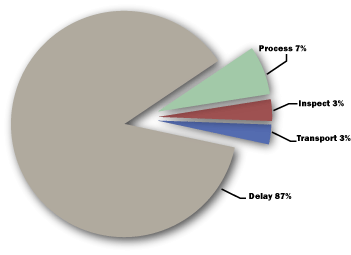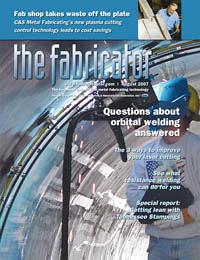- FMA
- The Fabricator
- FABTECH
- Canadian Metalworking
Categories
- Additive Manufacturing
- Aluminum Welding
- Arc Welding
- Assembly and Joining
- Automation and Robotics
- Bending and Forming
- Consumables
- Cutting and Weld Prep
- Electric Vehicles
- En Español
- Finishing
- Hydroforming
- Laser Cutting
- Laser Welding
- Machining
- Manufacturing Software
- Materials Handling
- Metals/Materials
- Oxyfuel Cutting
- Plasma Cutting
- Power Tools
- Punching and Other Holemaking
- Roll Forming
- Safety
- Sawing
- Shearing
- Shop Management
- Testing and Measuring
- Tube and Pipe Fabrication
- Tube and Pipe Production
- Waterjet Cutting
Industry Directory
Webcasts
Podcasts
FAB 40
Advertise
Subscribe
Account Login
Search
Lean tool and die solutions
Adapting to a new economy
- By Gary Gathen
- September 11, 2007
- Article
- Shop Management
Editor's Note: This article is adapted from Gary Gathen's conference that will be presented at FABTECH® International & AWS Welding Show, Nov. 11-14, 2007, Chicago, © 2007 by the Fabricators & Manufacturers Association Intl. (FMA), the Society of Manufacturing Engineers (SME), and the American Welding Society (AWS).
For those old enough to remember, in the 1950s the "Made in Japan" label basically meant "junk." You usually bought two because the product probably would break in a short time. Toyota sold its first car, the Toyopet, in 1957 and never looked back.
Fast-forward 50 years, and my how things have changed. In 2006 Toyota overtook GM to become the largest carmaker in the world, beating GM by less than 30,000 units. While GM suffered a net loss of $2 billion in 2006, Toyota earned more than $18 billion. This is more than the Big Three have ever earned together. Critics say that Toyota and other transplants don't have the legacy costs are that the Big Three do, which makes the difference. According to news reports, GM's legacy costs about $5 billion per year. Subtract that from Toyota's profit, and Toyota still earned $13 billion more than GM.
How can this be explained? The answer lies in how Toyota runs its plants. Because Japan has practically no natural resources, Japanese companies maximize everything.
Toyota became famous for the Toyota Production System (TPS) by taking the lead of such pioneers as Henry Ford and W. Edwards Deming. Deming tried, unsuccessfully, to convince U.S. manufacturers to adopt lean manufacturing. U.S. companies didn't buy what they thought was his brand of snake oil, so he went to Japan, where he was embraced. Other great U.S. engineers, such as Frederick W. Taylor (time study) and Frank B. Gilbreth (motion study), focused on the worker with excellent results.
In 1986 a team of MIT engineers undertook a five-year study of the global automotive industry, comparing all major automakers in the areas of productivity and efficiency. The resulting book, The Machine That Changed the World, coined the term lean manufacturing and revealed that Toyota and the other Japanese OEMs were the best carmakers.
Tool- and diemakers are in a unique situation. A diemaker usually makes only one die, which can produce millions of stampings. Tool and die shops manufacture a very small portion of the manufacturing contract, around 5 percent to 10 percent. Can lean principles be applied to the tool and die industry? Absolutely.
Tool and Die Lean Manufacturing 101
The lean journey is based on eliminating all waste (muda) and adopting just-in-time (JIT) delivery. Adding value is fundamental to becoming lean. This means delivering high-quality products to customers when, where, and in the exact quantities needed. The customer is the next step in the overall process, not the end user. For example, the die designer is a supplier to the diemaker, the diemaker is the supplier to his customer, the die tryout department, and so on. Every process step has a supplier and a customer inside or outside the company.
The following four things can be done to a piece of material:
- Process or make it more complete, which adds value
- Inspect it, which is necessary but adds no value
- Move it around the shop, which is necessary but adds no value
- Delay or standby, which adds no value
A study of tool and die shops found that during scheduled working hours, the four areas broke down as:
- Processing—7 percent
- Inspection— 3 percent
- Movement— 3 percent
- Delay—87 percent
If you study these areas in your own shop, it can be a shocking realization to see how much time is spent waiting and how little is in processing (see Figure 1). Try it.
Taiichi Ohno and Shigeo Shingo co-developed the TPS. The origin of JIT is based on cards, called kanban, which show descriptions, quantities, and other information needed to replenish stock beside a production line or assembly stations. The method was implemented when Ohno saw a card on a supermarket shelf for tomato soup. He saw a stock boy pick cards from nearly depleted shelves, which signaled the store needed to order more product from the warehouse (see Figure 2). Kanban cards enable JIT and cut lead-time.
Pricing Model. The typical pricing model used in most companies, including die shops, is
Cost + Profit = Selling Price. According to Shingo, that selling price is fixed by the market, not by the bidder. He proposed this pricing model: Selling Price — Cost = Profit. The terms are the same, but a focus on cost reveals that saving a dollar of cost puts that dollar right into profit. As a result, cost is the target.
Lean Can Work in Your Shop
What works for Toyota can work for you. The difficult part of eliminating waste is finding it. Every shop believes it's lean and mean. A common lean misconception is that you become lean by reducing head count. Lean is not about laying off employees; it's about reshaping a company's processes so fewer people are needed in production. However, by lowering costs and lead-times, your shop will capture more orders with its new cost structure and use freed-up workers to complete additional orders.
How do you find the waste? A fundamental lean tool is value stream mapping, which shows each step in the manufacturing process as well as individual processes associated with each product. For example, a CAD file is a product of the design department. Creating a value stream map graphically represents the actual time spent processing the CAD file, as well as delays or standby time.
Value stream maps can help eliminate 80 percent of design lead-time. Imagine reducing die design from six weeks to eight days. Similar reductions can be achieved in the build and tryout departments and in office paperwork. A number of software packages can assist in the drawing and calculating functions, although many people still use pencil and paper to create their own spreadsheets.
It's important to note that a systemwide approach is key, because improving a process in just one area or department can cause a negative impact somewhere else. Hiring a consultant may foster faster improvement with earlier improved bottom-line results.
To achieve a competitive position against low-cost countries, your shop must reduce costs by at least 25 percent and shorten lead-time by about 50 percent. These numbers are well within reach if you make a commitment, gain buy-in from everyone from the janitor to the president, and keep at it until you hit targets. Then continue to improve, and be sure to sustain the levels you've attained.
About the Author
Gary Gathen
21 Elm Park Blvd.
Pleasant Ridge, MI 48069
248-543-5400
subscribe now

The Fabricator is North America's leading magazine for the metal forming and fabricating industry. The magazine delivers the news, technical articles, and case histories that enable fabricators to do their jobs more efficiently. The Fabricator has served the industry since 1970.
start your free subscription- Stay connected from anywhere

Easily access valuable industry resources now with full access to the digital edition of The Fabricator.

Easily access valuable industry resources now with full access to the digital edition of The Welder.

Easily access valuable industry resources now with full access to the digital edition of The Tube and Pipe Journal.
- Podcasting
- Podcast:
- The Fabricator Podcast
- Published:
- 05/07/2024
- Running Time:
- 67:38
Patrick Brunken, VP of Addison Machine Engineering, joins The Fabricator Podcast to talk about the tube and pipe...
- Trending Articles
How laser and TIG welding coexist in the modern job shop

Young fabricators ready to step forward at family shop

Material handling automation moves forward at MODEX

A deep dive into a bleeding-edge automation strategy in metal fabrication

BZI opens Iron Depot store in Utah

- Industry Events
Laser Welding Certificate Course
- May 7 - August 6, 2024
- Farmington Hills, IL
World-Class Roll Forming Workshop
- June 5 - 6, 2024
- Louisville, KY
Advanced Laser Application Workshop
- June 25 - 27, 2024
- Novi, MI
Precision Press Brake Certificate Course
- July 31 - August 1, 2024
- Elgin,





























